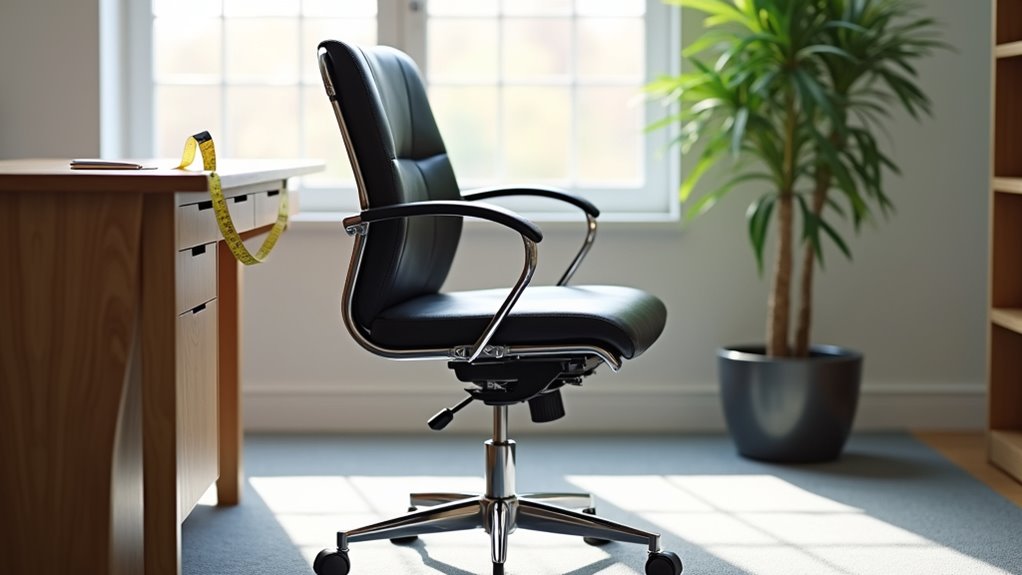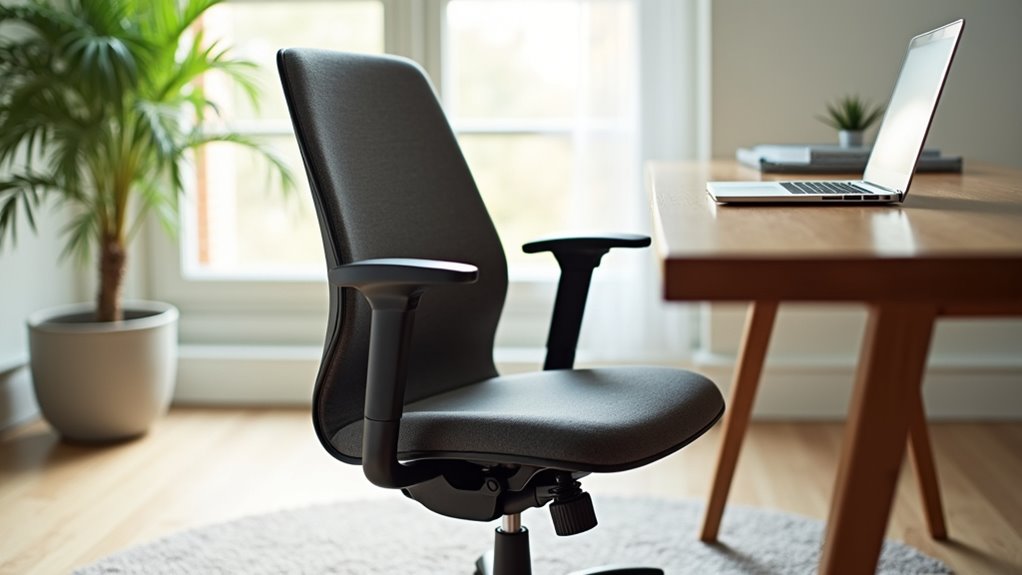How to Sit in a Chair
This post contains affiliate links. As an Amazon Associate, we earn from qualifying purchases.
To sit correctly in a chair, scoot your butt all the way back so it touches the backrest, and use lumbar support to maintain the natural curve of your lower back, keeping your spine straight. Adjust your chair height so your feet rest flat on the floor with your knees at about 90 degrees, ensuring there’s enough space behind your knees for comfortable circulation. Finally, make sure your elbows are close to your body and your arms are relaxed. For those interested in a deeper understanding, further details and tips will follow later in the article.
Essential Facts in 30 Seconds
- Sit fully back in the chair for lumbar support.
- Adjust seat height so feet are flat on the floor and knees are bent at 90 degrees.
- Maintain a 2-4 inch gap between the seat edge and the back of your knees for circulation.
- Position hips and knees at 90 to 100 degrees, with sit bones slightly forward.
- Align arms with the desk, keeping elbows close and forearms parallel for comfort.
Proper Lumbar Support and Back Position
Getting comfy in your chair starts with proper lumbar support. This support is important for your back.
Sit all the way back in your chair. Make sure your buttocks touch the backrest. Place your lumbar support between your waistband and belly button. It should fit right in your lower back’s natural curve.
The support should fill the gap without pushing too hard. This keeps your spine aligned and helps you avoid slouching. Adjust the support until it hugs your back gently. No pressure points should hurt you. Proper lumbar support reduces lower back pain and enhances your overall sitting experience. Additionally, effective lumbar support can maintain spine alignment, contributing to better long-term health. Using a lumbar roll can provide additional support if your chair lacks it. Correct sitting posture also reduces strain on back and neck, promoting overall well-being.
If your chair has adjustable lumbar support, use it. You can customize it to fit your spine. Think of it as your personal back coach. Comfortable back muscles mean less pain during long hours of sitting.
Keep your back happy!
And if you spill something, like ketchup, just clean it up quickly. Treat it like a ninja and make that stain disappear!
Adjusting Seat Height and Knee Alignment

Adjusting your seat height and knee alignment is key to comfort. Start by making sure your feet rest flat on the floor. This helps you feel stable and keeps blood flowing. Bend your knees at about a 90-degree angle. This position reduces stress on your joints. Keep your knees level with or slightly below your hips. This will support your back. Additionally, proper height adjustment is crucial for maintaining optimal support.
Next, check for a gap of 2-3 inches between the seat edge and the back of your knees. This gap promotes good circulation. If your feet don’t reach the ground, use a footrest. This way, your legs won’t hang down. Maintaining proper height ensures blood circulation and reduces lower back strain. Additionally, maintaining good posture while sitting is crucial for overall comfort and health. Familiarize yourself with the lever mechanism to make height adjustments easy and effective.
Follow these tips, and you’ll enjoy a comfortable sitting experience!
Optimizing Seat Depth and Thigh Support
Now that your seat height and knee alignment are set, let’s focus on seat depth and thigh support. Getting this right is important for comfort and good posture. Measure from the back of your hips to about two inches behind your knees. Aim for a seat depth that leaves a 2-4 inch gap. This gap helps blood flow and avoids pressure behind your knees. Getting the seat depth right is crucial to prevent discomfort in your lower back and thighs. Additionally, proper back support can enhance overall comfort and stability while seated. Furthermore, good posture not only improves comfort but also reduces the risk of discomfort and pain. Having adequate padding in your chair can also significantly increase your overall comfort during long hours of sitting.
Here’s a quick guide:
| Height | Recommended Seat Depth |
|---|---|
| Short (5’0″ – 5’4″) | 17–20 inches |
| Medium (5’5″ – 5’9″) | 20–23 inches |
| Tall (5’10” – 6’2″) | 23–24 inches |
| Very Tall (6’3″+) | Custom depth needed |
| Adjust your chair | Find the perfect fit! |
With the right seat depth and thigh support, you will feel great. You’ll be ready to face anything that comes your way!
Pelvic and Hip Positioning Techniques

To sit comfortably, focus on your pelvic and hip positioning.
Start by finding your sit bones. Place your palms under your butt while sitting on a firm surface. Rock your hips forward and back until you feel your sit bones pop out. Sit slightly forward of that spot for better stability. Proper chair height adjustment is essential for achieving optimal posture.
Keep your hips and knees at about 90 to 100 degrees. Your feet should be flat on the floor. If your feet don’t reach, use a footstool. This helps your knees stay lower than your hips. Proper positioning is essential for maintaining balance and reducing leg strain.
A small tilt in your pelvis is natural. Engage your hip flexors by lifting your knees a bit while keeping your feet on the ground. This helps avoid low back pain. Proper sitting techniques can alleviate strain on the lower back.
Good posture is key!
Maintaining Arm and Shoulder Alignment
Getting your pelvic and hip positioning right is important. It helps your upper body, especially your arms and shoulders.
Adjust your chair’s armrest height. Your elbows should stay close to your body and bend between 90 and 120 degrees. This keeps your shoulders down and prevents shrugging. Keep your forearms parallel to the desk. This makes typing easy and reduces shoulder strain. Additionally, make sure to adjust chair height so that your knees are at or slightly below hip level, which enhances overall comfort. Proper backrest alignment is also crucial for spinal support.
If your desk won’t move, change your chair height. Look for a comfortable fit. Leave a little space between your forearms and the desk edge. Nobody likes feeling trapped!
Good shoulder positioning keeps you looking relaxed and feeling good at work. Additionally, ensure that your chair height adjustment is set so that your feet are flat on the floor for optimal comfort. Take a deep breath, adjust those armrests, and make your workspace better! Celebrate your comfy setup!
Frequently Asked Questions
What Type of Chair Is Best for Prolonged Sitting?
Ergonomic chairs are the best choice for long hours of sitting. They provide excellent lumbar support. This support helps keep your back healthy and reduces pain. Adjustability is another key feature. You can change the height, armrests, and seat depth to fit your body. Comfort is crucial too. A good chair makes it easier to focus and work longer without discomfort.
Studies show that ergonomic chairs can improve productivity. They help decrease fatigue and increase energy. Many people who switch to ergonomic chairs feel better throughout the day. It’s a smart investment for anyone who sits for long periods. Choosing the right chair can make a big difference in your comfort and health.
How Often Should I Take Breaks While Sitting?
To stay productive, take breaks every 30 minutes. Stand up, stretch, and walk around. These short breaks help refresh your mind and body. They improve focus and decrease tiredness. Sitting too long can make you feel sluggish. Moving a little can make a big difference. A quick walk or some stretches can boost your energy. Keeping this habit can help you work better every day.
Can Sitting Posture Affect My Mood?
Sitting posture plays a big role in how you feel. Sitting up straight can lift your mood. It helps you think more positively. Slouching, on the other hand, can lead to sadness. This poor posture may bring on negative thoughts. Good posture not only makes you look confident, but it also helps you feel better. Remember, your body position can change your feelings. So, sit tall and see how it helps your mood!
What Exercises Can Help Improve Sitting Posture?
To improve sitting posture, focus on core strengthening exercises. Try chin tucks to align your neck. Wall slides can help strengthen your back. Include flexibility exercises too. Seated side bends stretch your sides. Shoulder rolls release tension in your shoulders. These exercises build stability and reduce discomfort. Practicing them regularly makes a big difference. Good posture leads to better comfort and health.
Is It Better to Sit or Stand While Working?
Sitting and standing both have their pros and cons at work. Sitting offers comfort and helps you focus. You can stay in one place and do your tasks easily. But too much sitting can lead to stiffness and discomfort.
On the other hand, standing keeps you active. It can improve your mood and energy. Yet, standing for long periods can cause tiredness and sore feet.
To get the best results, switch between sitting and standing. This balance helps you stay productive and feel better throughout your workday. Listen to your body. Find what works best for you.
Conclusion
Keep your back straight. Adjust your chair height. Find the right spot for your thighs. Balance is key. Relax your arms. Make sure your hips feel good. Your knees should be at a comfortable angle.
Spill something? Clean it up quickly and move on. Try these tips. Sit comfortably and own that seat like a champ!
